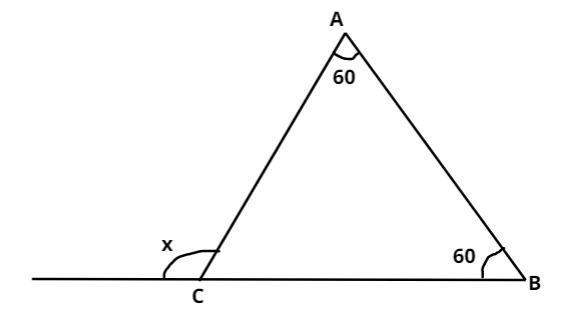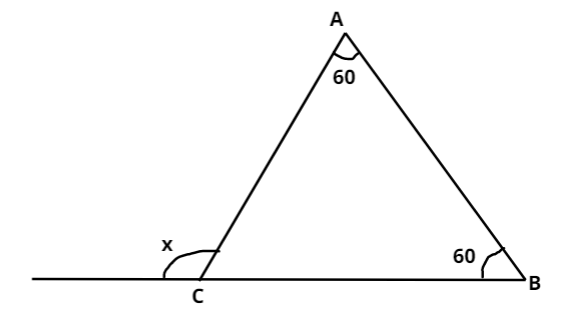
Find the value of the unknown exterior angle $x$ in the following diagram.


Answer
567.9k+ views
Hint: First of all find the third unknown angle of the triangle by using the condition that the sum of all internal angles of a triangle is ${180^ \circ }$. Then, the sum of this unknown angle and exterior angle $x$ is ${180^ \circ }$ because these two angles are supplementary as it is evident from the figure. Use this condition to find the required value.
Complete step-by-step answer:

Let the vertices of the triangle are A, B and C as shown in the above figure.
Two of the triangle’s angles are already given in the question. So we have:
$ \Rightarrow < A = {60^ \circ }$ and $ < B = {60^ \circ }$
According to the triangle's law, we know that the sum of all the internal angles of a triangle is ${180^ \circ }$. Applying this law for the above triangle, we’ll get:
$ \Rightarrow < A + < B + < C = {180^ \circ }$
Putting $ < A = {60^ \circ }$ and $ < B = {60^ \circ }$, we’ll get:
\[
\Rightarrow {60^ \circ } + {60^ \circ } + < C = {180^ \circ } \\
\Rightarrow < C = {180^ \circ } - {120^ \circ } = {60^ \circ }{\text{ }}.....{\text{(1)}}
\]
Thus the third internal angle of the triangle is also \[{60^ \circ }\].
Further, from the figure, we can say that the sum of the internal angle C and the external angle $x$ is ${180^ \circ }$ because these two angles are supplementary i.e. lying on the same side of a straight line. So we have:
$ \Rightarrow < C + x = {180^ \circ }$
Putting the value of \[ < C = {60^ \circ }\] from equation (1), we’ll get:
$
\Rightarrow {60^ \circ } + x = {180^ \circ } \\
\Rightarrow x = {180^ \circ } - {60^ \circ } \\
\Rightarrow x = {120^ \circ }
$
Therefore, the value of exterior angle $x$ is ${120^ \circ }$.
Note: When all the angles of a triangle are equal then the triangle is called equilateral triangle. The measure of each angle in such a triangle is \[{60^ \circ }\]. Thus the triangle in the above question is an equilateral triangle.
When only two angles of a triangle are the same then the triangle is called isosceles triangle. And when all the angles are different then it is called scalene triangle.
Complete step-by-step answer:

Let the vertices of the triangle are A, B and C as shown in the above figure.
Two of the triangle’s angles are already given in the question. So we have:
$ \Rightarrow < A = {60^ \circ }$ and $ < B = {60^ \circ }$
According to the triangle's law, we know that the sum of all the internal angles of a triangle is ${180^ \circ }$. Applying this law for the above triangle, we’ll get:
$ \Rightarrow < A + < B + < C = {180^ \circ }$
Putting $ < A = {60^ \circ }$ and $ < B = {60^ \circ }$, we’ll get:
\[
\Rightarrow {60^ \circ } + {60^ \circ } + < C = {180^ \circ } \\
\Rightarrow < C = {180^ \circ } - {120^ \circ } = {60^ \circ }{\text{ }}.....{\text{(1)}}
\]
Thus the third internal angle of the triangle is also \[{60^ \circ }\].
Further, from the figure, we can say that the sum of the internal angle C and the external angle $x$ is ${180^ \circ }$ because these two angles are supplementary i.e. lying on the same side of a straight line. So we have:
$ \Rightarrow < C + x = {180^ \circ }$
Putting the value of \[ < C = {60^ \circ }\] from equation (1), we’ll get:
$
\Rightarrow {60^ \circ } + x = {180^ \circ } \\
\Rightarrow x = {180^ \circ } - {60^ \circ } \\
\Rightarrow x = {120^ \circ }
$
Therefore, the value of exterior angle $x$ is ${120^ \circ }$.
Note: When all the angles of a triangle are equal then the triangle is called equilateral triangle. The measure of each angle in such a triangle is \[{60^ \circ }\]. Thus the triangle in the above question is an equilateral triangle.
When only two angles of a triangle are the same then the triangle is called isosceles triangle. And when all the angles are different then it is called scalene triangle.
Recently Updated Pages
Master Class 9 Social Science: Engaging Questions & Answers for Success

Master Class 9 Science: Engaging Questions & Answers for Success

Master Class 9 English: Engaging Questions & Answers for Success

Master Class 9 Maths: Engaging Questions & Answers for Success

Master Class 11 Economics: Engaging Questions & Answers for Success

Master Class 11 English: Engaging Questions & Answers for Success

Trending doubts
Which places in India experience sunrise first and class 9 social science CBSE

Fill the blanks with the suitable prepositions 1 The class 9 english CBSE

Write the 6 fundamental rights of India and explain in detail

Difference Between Plant Cell and Animal Cell

What is the Full Form of ISI and RAW

Golden Revolution is related to AFood production BOil class 9 social science CBSE




